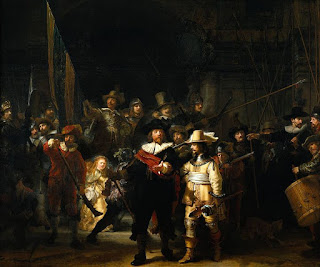Rembrandt was born in Leyden to a miller and the daughter of a baker. His father owned a windmill and people came to use the saying that Rembrandt was "born in a windmill". He was brought into a family of five siblings. His father decided that he should study to be a lawyer but instead he turned to art. He received his earliest training from a relative by the name of Jacob van Swanenburch before moving onto more skilled masters. He finally moved to Amsterdam and married a wealthy lady by the name of Saskia van Ulenburg.
The painting is conducted of a Musketeer company. Captain Frans Banning-Kock and his company paid Rembrandt for a historic and glorious picture walking in the middle of day in their full dress. The two figures walking are Frans Banning-Cocq, Lord of Furmerland and Ipendam, the company captain. The archers guild who commissioned the painting refused to give Rembrandt the money because their faces were not clearly visible. He thus received the worst compensation out of any of his paintings.
The Musketeer (mousquetaire) was considered part of the basic infantry in early European history. They could at times be used as a dragoon on horseback and were lightly armed. Around 1850's they were replaced by rifleman except in Germany where they maintained the name until WWI. They were also used in Turkey where the famous Janissary Corps was formed. China also used the musketeers since the 1400s. At times the muskets were adapted to shields and created slow burn machine guns by turning the shield as each shot was fired.
The painting was drawn during the Dutch Golden Age that lasted from 1568-1648. The time was marked by increased wealth and flourishing works in trade, science, military and art. In 1568 seven provinces signed the Union of Utrech which started the 80 years war as a rebellion against Spain. This war continued until the Peace of Westphalia which gave the country formal recognition. The Dutch East India company started the first modern stock market and the Bank of Amsterdam was established as the first central bank.

No comments:
Post a Comment